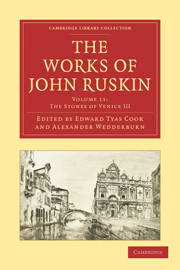INTRODUCTION TO THIS VOLUME
Published online by Cambridge University Press: 07 September 2011
Summary
The third volume of The Stones of Venice was published very shortly after the second, and much of it was written in Venice during the winter of 1851–1852. We have already described Ruskin's work there, and discussed the reception and significance of the book. Little, therefore, is necessary here as an introduction to the present volume. The contents of the third volume are, however, somewhat varied, and an explanation of their scope may serve to show their several relations to Ruskin's scheme.
The volume may be described as containing a conclusion, a résumé, and an appendix. The first three chapters deal with the Third Period of Venetian Architecture, that of the Renaissance. This portion of the subject is treated less fully than either of the former periods, and to a large extent it resolves itself into a discussion of the sepulchral monuments. These were selected by Ruskin as affording the most interesting and striking instance by which to illustrate the contrast between the Gothic and Renaissance spirit. His account of the Tombs of Venice—given in ch. ii. §§ 46-85—was, as originally planned, on a much more extensive scale. Many more tombs were to be included, and each tomb was to be described in detail, as the following memorandum among his MSS. shows:—
“General Plan. Observe: we have in each tomb to examine, first, its plan and feeling; then, its manner of sculpture and mouldings; and in examining these last we shall incidentally compare with them such parallel works of sculpture as bear a date.”
- Type
- Chapter
- Information
- The Works of John Ruskin , pp. xv - xxxPublisher: Cambridge University PressPrint publication year: 2010First published in: 1904



